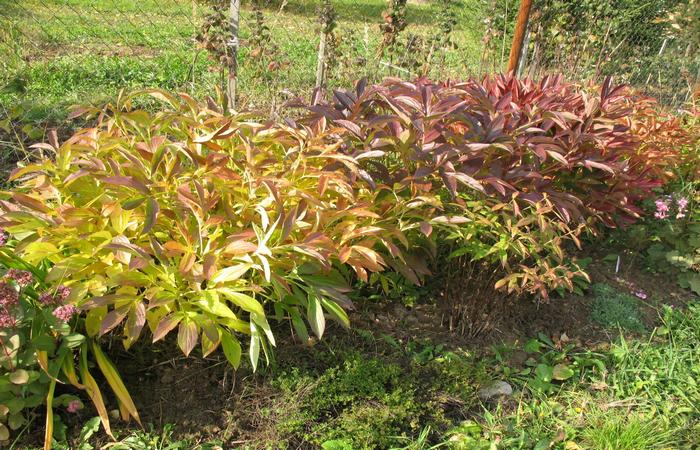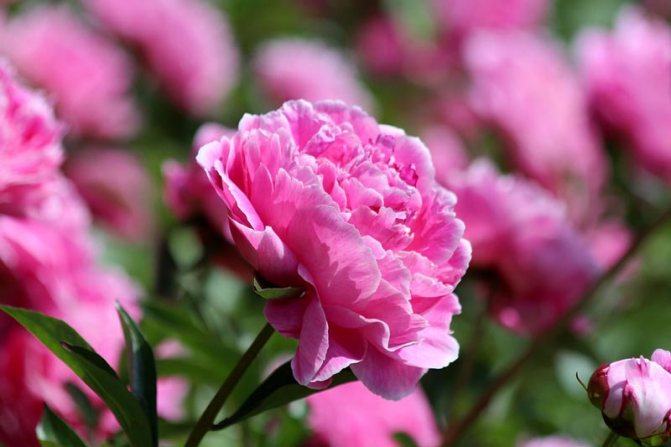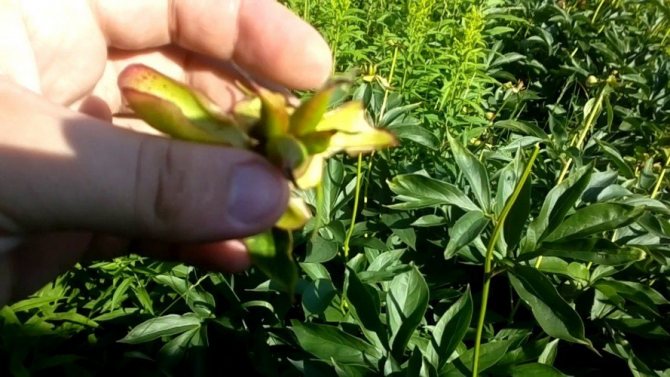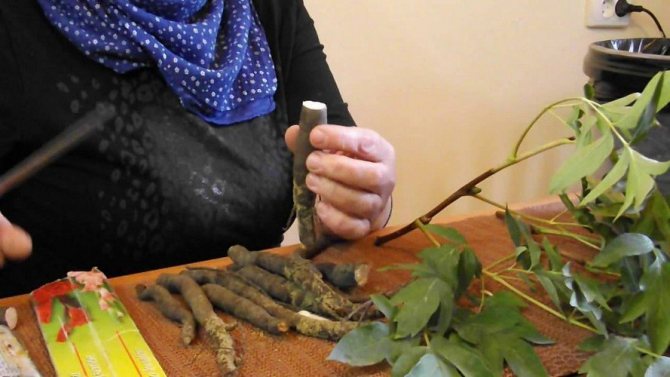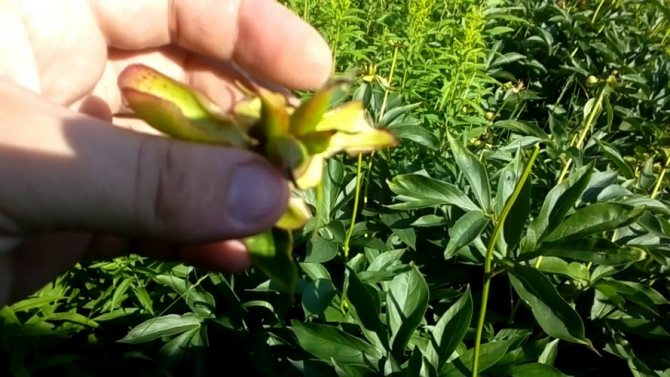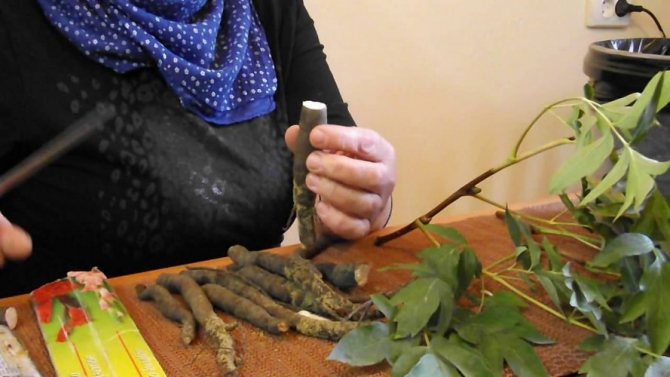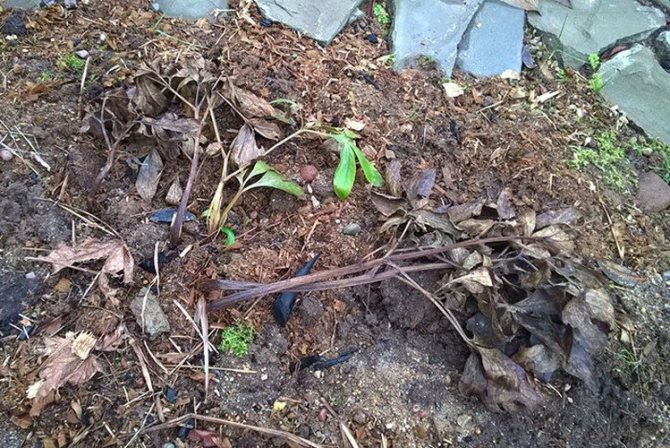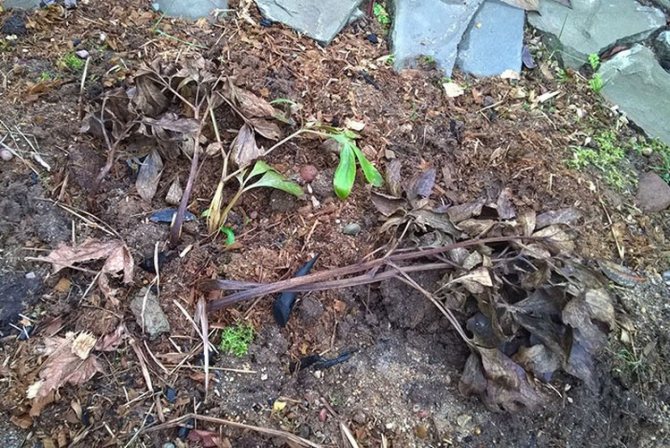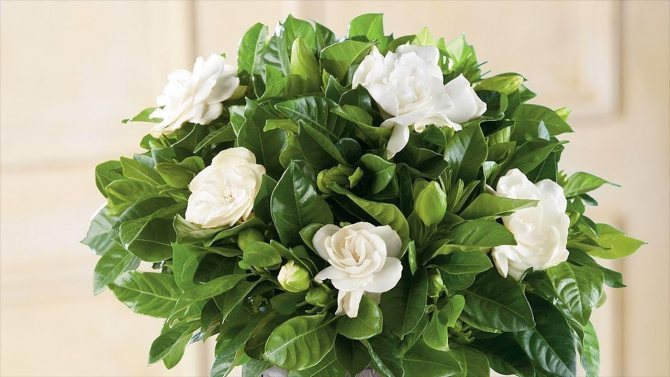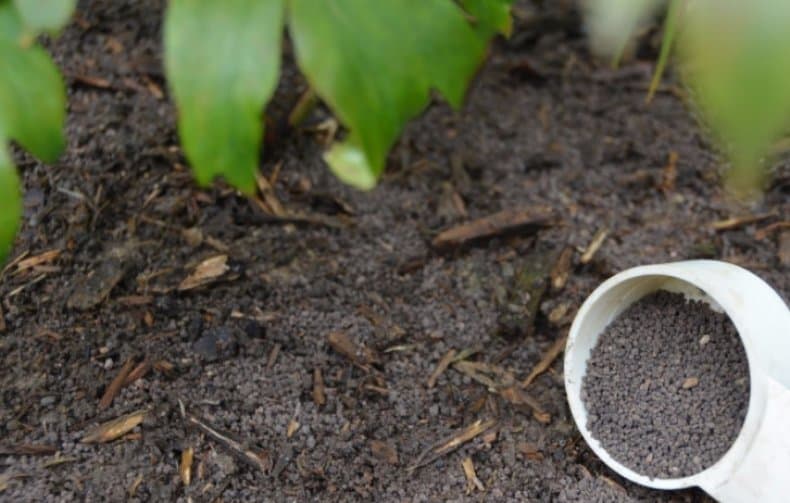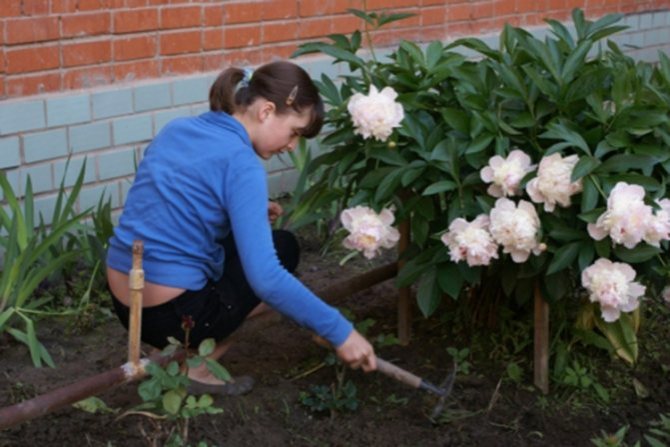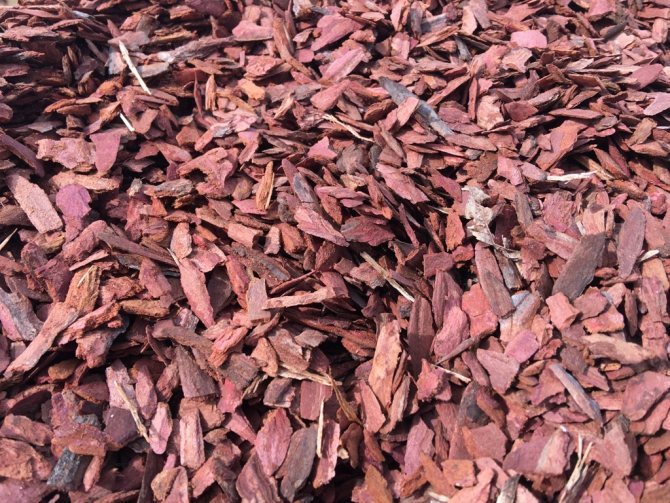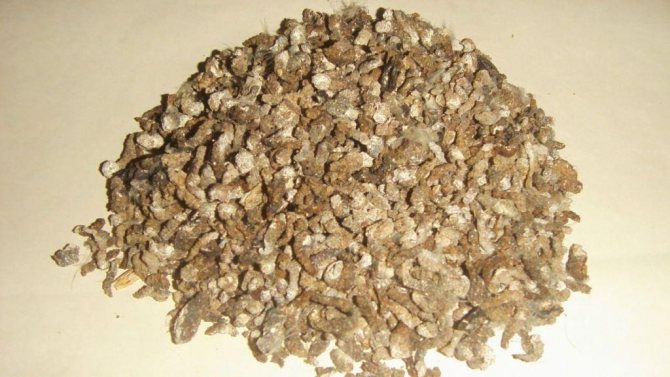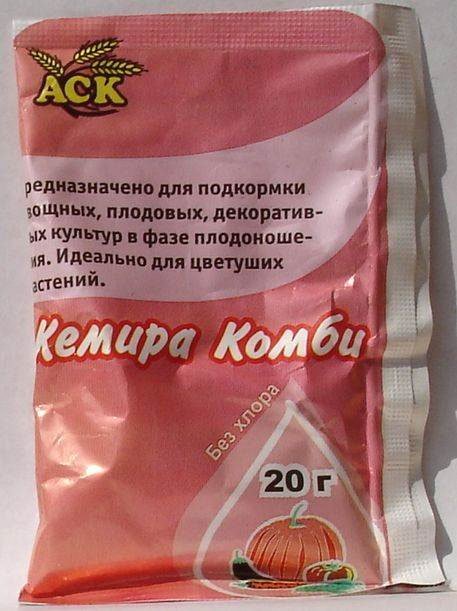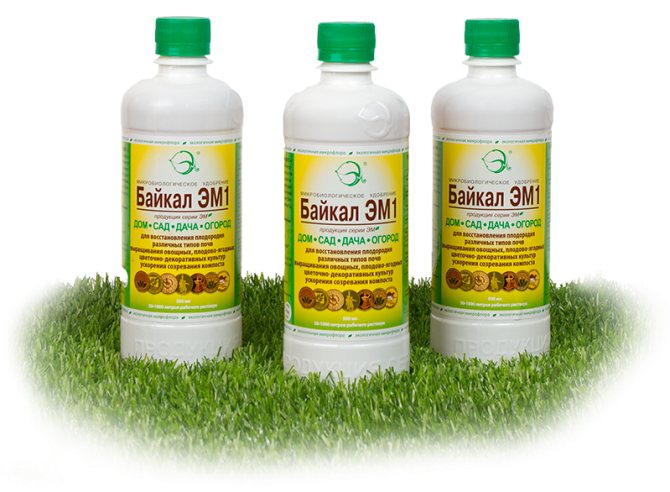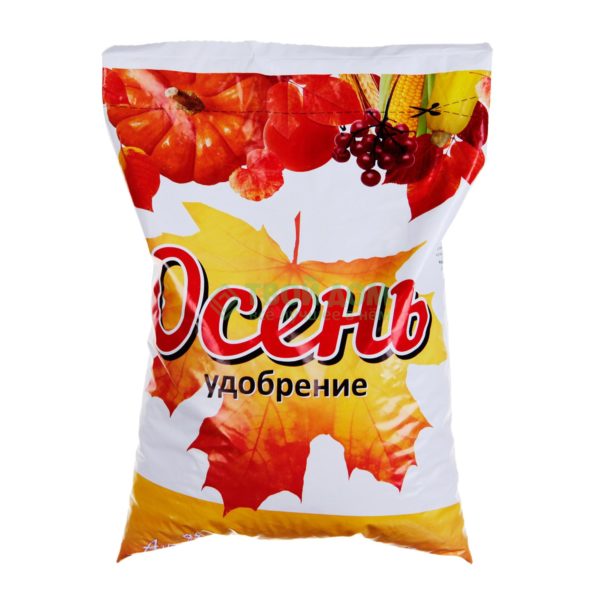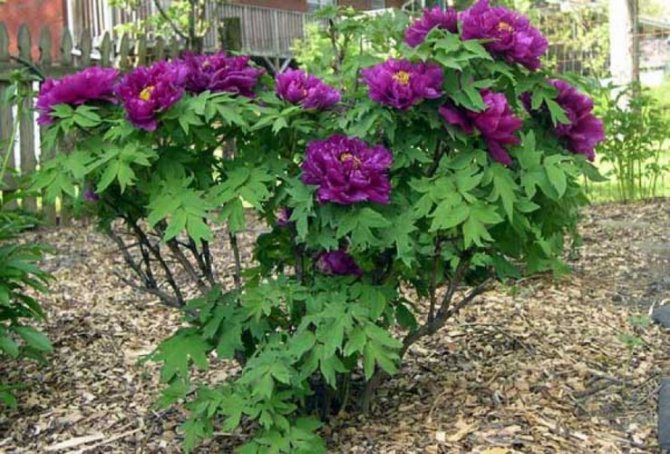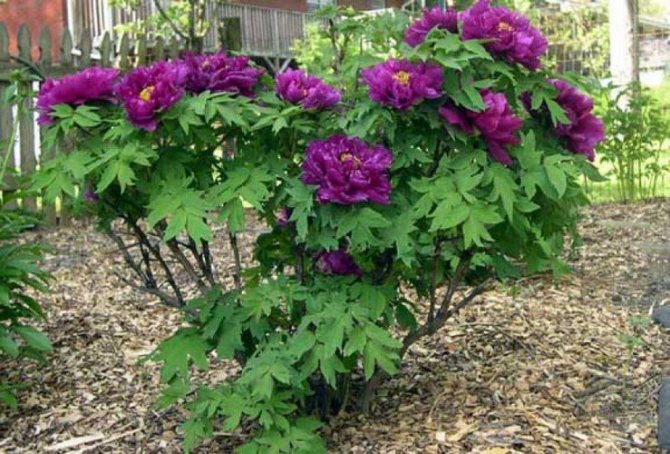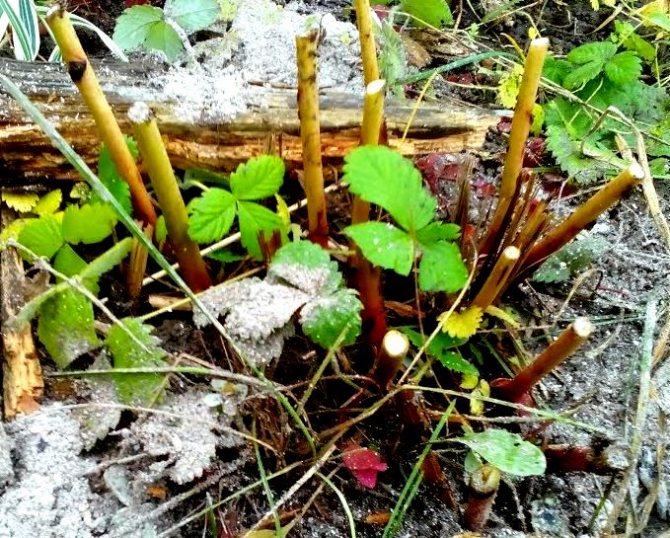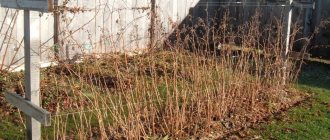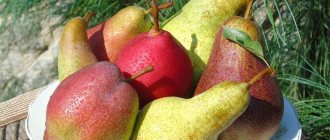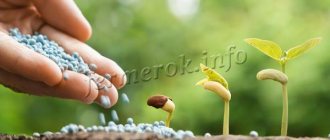It is necessary to feed peonies after flowering for every gardener who breeds them in his personal plot. This is because it requires nutrients that are not always present in the soil to produce lush greenery and beautiful buds. The plant should be provided with a complex of minerals three times per season, and the last time it is better to feed the peonies in October. It is not advisable to neglect the procedure, this can negatively affect the condition and appearance of the culture.
Peony bloom lasts no more than 2-3 weeks
Autumn care for peonies
In the fall, it is imperative to prune the peonies. A common mistake of novice gardeners, which becomes detrimental to the plant, is that the pruning of peonies is carried out in the summer under the root immediately after flowering. Such pruning can affect the further development of the plant and deprive it of flowering. When the peony fades, it continues to live an active life, important processes take place in the plant, buds are laid for the next year.
Buds during this period are formed on the roots of the peony. New stems will grow from them in the spring. Peony needs a lot of nutrients and vitality to grow buds. They enter the root through the green mass and stem. By pruning the bush, removing the leaves and stem, the peony is deprived of nutrition. Therefore, it is strictly forbidden to prune peonies in the summer.
You need to prune peonies, but you need to do this later, better before the very frosts: at the end of September - at the beginning of October. It is convenient to use secateurs for this. You should leave a stump with a height of 2-3 cm. In the summer after flowering, it is enough just to remove the faded flowers, otherwise there is a risk of gray rot on the petals.
What needs to be fed?
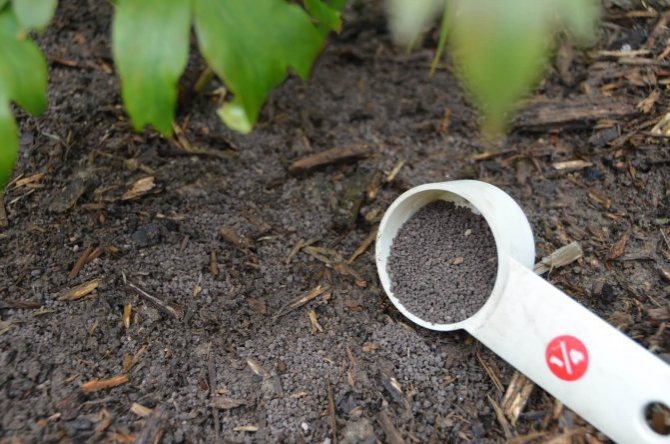
Minerals needed for peonies in autumn - primarily potassium and phosphorus
Like all other flowering plants, peonies need nutrients necessary for the formation of leaves and inflorescences:
- potassium;
- phosphorus;
- nitrogen.
The peculiarity of autumn feeding is that the application of fertilizers with nitrogen content can lead to a deterioration in the frost resistance of plants, therefore, after flowering, peonies only need potassium and phosphorus. As a top dressing, you can use both special mixtures that are sold in stores for gardeners, and natural organic fertilizers.
Fertilizer when planting
In order for the peony to grow well and bloom actively, it is better to plant it in the autumn. At the same time, the bush is fed, after which fertilization will not be required for the next three years until the plant blooms.
Pruning and feeding flowers
During planting, holes are made with sides and a depth of 60 centimeters. About 20 kilograms of humus or peat are laid at the bottom of the pit. About 300 grams of bone meal is added to it. Instead, you can add 200 grams of superphosphate. If the soil is clay, then a bucket of sand is added to the contents of the planting pit. If the soil is sandy, then the same amount of clay will be required.
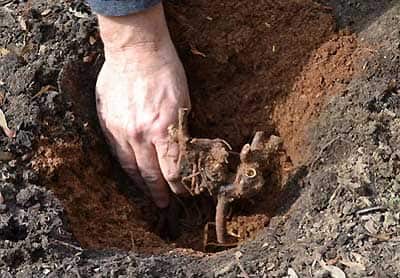

Peony transplant process
When digging a hole, the top fertile soil layer must be set aside, and then added to the rest of the contents. The resulting mixture is tamped so that the pit is 35 centimeters full.Next, a sand layer 20 centimeters thick is made and seedling rhizomes are laid on it. From above they are covered with fertile soil so that the buds are at a depth of five centimeters.
Planting tree peonies
Consider how planting and care in the open field for a peony is carried out. Planting is carried out in August-September. It is necessary to choose a sunny site for planting. There should be no tall trees nearby so that no shadow falls on the peonies. You can plant peony bushes in the form of a hedge.
Loamy soil is best suited, if the soil is sandy on the site, you need to add peat, clay or humus to it. Clay soil is fertilized with organic fertilizers and sand. The place must be taken care of carefully, since in one place a peony can be grown for 80-100 years.
You may be interested in: How to independently plant a thuja in open ground?
Dig a conical hole about 70 cm deep and the same diameter. A 30-centimeter layer of sand and broken brick is poured onto the bottom. With acidic soil, bone meal or lime is added, then the soil is poured, the plant is placed and a lot of water is poured so that the roots of the tree peony are straightened in it. As soon as the water is absorbed, the pit is filled up. It is necessary to plant bushes of tree-like peonies, retreating from each other by two meters.
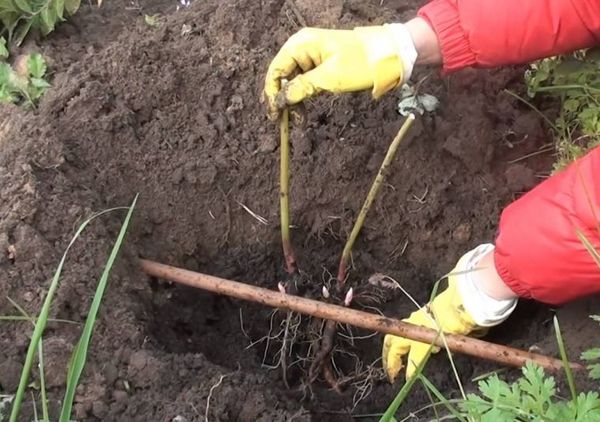

Growing peonies from seeds
You can plant a tree-like peony with seeds, then the plant will be able to bloom within 5 years after planting. The main thing is to stratify. The procedure is carried out in two stages: warm, then cold. But even such manipulations do not guarantee that the plant will grow, since peonies need careful care.
Feeding rules in the fall
The rules for feeding peonies in the autumn period depend on their age and the climatic conditions of the region. You need to feed only those bushes that have reached the age of three. Fertilizers are not required for young plants, and the effect of the procedure may be the opposite. Ripe peonies, on the contrary, require regular feeding, and the older the flower, the more nutrients it needs.
The optimal time for top dressing is from the second half of September to the first half of October, but the work must be carried out in such a way as to finish them 1–1.5 months before the first frost. The type of fertilizer depends on the characteristics of the soil and weather conditions:
- on sandy and depleted soils, too much minerals can inhibit the growth of flowers, so it is better to apply fertilizing twice with an interval of two weeks;
- for alkaline and slightly acidic soils, it is recommended to use superphosphate, which contributes to the formation of beautiful, lush inflorescences and improves the characteristics of the earth;
- organic matter and potassium-phosphorus fertilizers are suitable for any soil - they contain the whole range of nutrients and saturate the soil well with them.
In dry weather, fertilizing is applied in liquid form, and when a large amount of precipitation falls, dry (granular) mixtures are used - liquid fertilizers will simply be washed off with water and will not benefit the plants.
Plant features
The tree peony is a deciduous shrub. The size of the plant can be up to 1.5-2 meters. The leaves of the flower are ornamental, openwork. Stems are brown, thin enough. It should be noted that they do not die off in autumn, but only increase every year. Large flowers with a diameter of 12-20 centimeters are located at the ends of the shoots.
There are many colors: from white and light pink to bright purple, crimson. There are two-color species. Tree peony cold-resistant.
There are three main plant varieties:
- Japanese.
- Sino-European.
- Hybrid.
The number of flowers is directly proportional to the age of the peony: the older it is, the more luxuriant it blooms. The average flowering period of a plant is about two to three weeks.Planting and caring for tree peonies is standard, but attention must be paid to the characteristics of the plant.
Autumn peony transplant
Once every five to six years, the bushes must be transplanted from one place to another. This helps to rejuvenate the bushes, get more flowers from them, which will be lush and strong. The transplant is carried out precisely in the fall, at the beginning of September, in the conditions of Siberia, this period is shifted to the end of August. An autumn transplant helps to prepare peonies for winter by providing plants with substances that are responsible for growth and development.
The features of the autumn transplant of peonies include:
- The works are carried out in warm and always dry weather.
- The soil must be moistened before transplanting, which will help to gently dig up the plants.
- The roots of the bushes must be rinsed with water, cleaned of soil.
- The rhizomes are examined for disease, rot, and parasites.
- It is necessary to remove the old roots, and put the young ones in a container with a weak solution of potassium permanganate.
- After 40 minutes, the roots will be processed, and the bush can be immediately planted in the ground. It is better to do this in a new place, which should be well lit by the sun. If the light of natural origin is not enough, then the peonies will bloom poorly.


The place of the future planting of the bushes is dug in advance, loosened, fertilized with superphosphate. It is prohibited to use nitrogen mixtures and fertilizing. A mixture of compost (three parts) and wood ash (one part) should be placed in each hole. The roots must be laid out very neatly, the upper bud should look out of the ground. The hole is covered with earth and watered abundantly with water.
Before the onset of frost and autumn rainy weather, the bushes should be watered abundantly, two to three times a week. Top dressing is no longer carried out.
Growing conditions
Peonies are considered light-loving plants, it is because of this that a sunny area will be required for harmonious growth, best of all - on a small elevation. Plants do not tolerate a transplantso the landing site must be constant. It is better if there are no other large plants around, such as shrubs or trees.
Growing a tree peony will require early preparation of the site and soil. Flooded areas with excessive moisture are not suitable for the growth of a tree peony. If there is no alternative, it will be necessary to install drainage and ensure the removal of excess moisture. Give preference to soils with an alkaline reaction (pH 7.5 to 8).
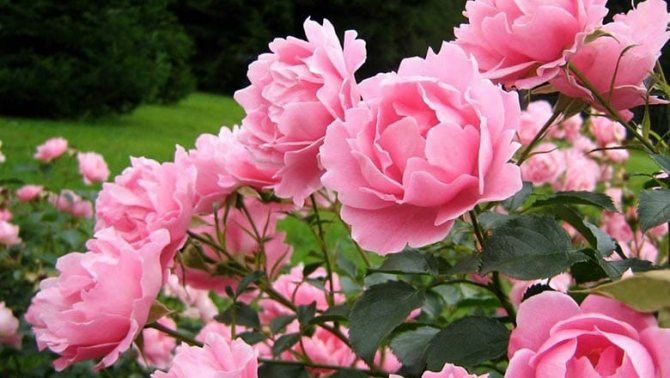

Feeding methods
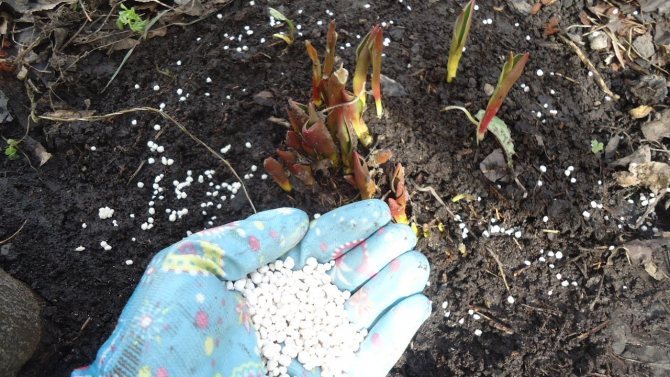

Peonies use up almost all the previously accumulated nutrients in summer. Top dressing in the fall is needed for a beautiful flowering. There are several ways to carry it out:
- Basal. The best way to feed is by placing the nutrient under the roots. The ground around the plant is watered and granules are scattered. The dissolved substances are poured onto the roots.
- Foliar. This is not a fall method. With this method, the bush is sprayed when the buds begin to bloom. 2 tablets of micronutrient fertilizer are diluted in 10 liters of water, sprayed in the evenings in cloudy weather. Spraying in sunny weather can cause sunburn.
- Into the hole. Peonies are rarely transplanted, sometimes every 10-15 years. If they are transplanted, then in the fall, fertilizer is added to a pre-prepared hole. The bottom of the hole is covered with mixed bone meal and humus.
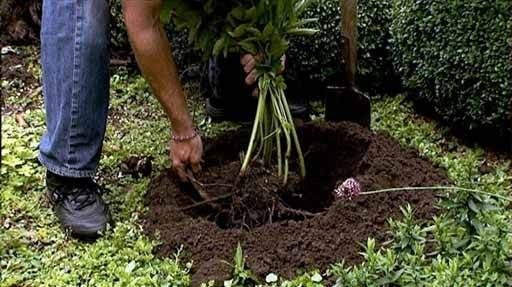

You may be interested in:
Mineral fertilizers
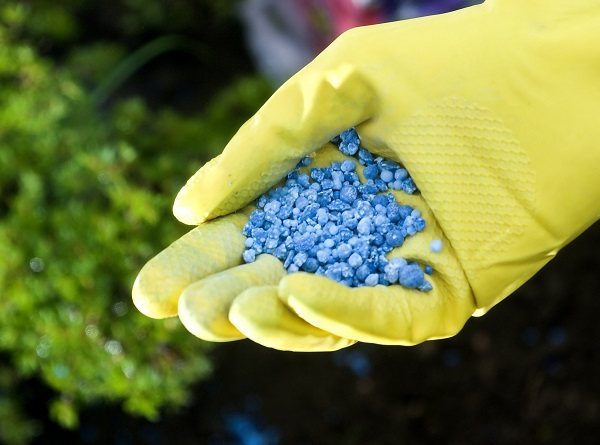

To avoid burns, fertilize the plant with extreme caution.
How can you feed peonies in the fall? First of all, these are potassium and phosphate, which can be applied to the soil both in dry and liquid form. In the first case, the algorithm of actions is as follows.
- Dig small grooves 6–8 cm deep around the bushes, then slightly moisten the soil.
- For each bush, take 20 g of phosphorus and 15 g of potassium, sprinkle the fertilizer, avoiding getting the mixture on the sensitive neck of the plants, otherwise burns may remain on them.
- Spill the soil again so that the granules dissolve well.
To add potassium and phosphate in liquid form, dissolve in a bucket of pre-settled water at room temperature, then pour the solution over the bushes. You can use multicomponent fertilizers - superphosphate, potassium sulfate, Kemira-Kombi or Kemira-Autumn. Most often, they are sold in the form of tablets, the optimal dosage is 1 tablet per bucket of water, top dressing is applied in the same way as the potassium-phosphorus mixture in liquid form.
Feeding peonies in June, July and August
Experienced gardeners do not recommend fertilizing peonies during flowering, this can lead to rapid shedding of the petals. Top dressing is continued after all the buds have wilted, and if seed collection is not planned, the inflorescences are cut off. In summer, plants recuperate and begin to lay buds (next season), during this period they cannot be left without nutrients. The best results are obtained by feeding peony bushes (after flowering) in July, especially when grown in the south.
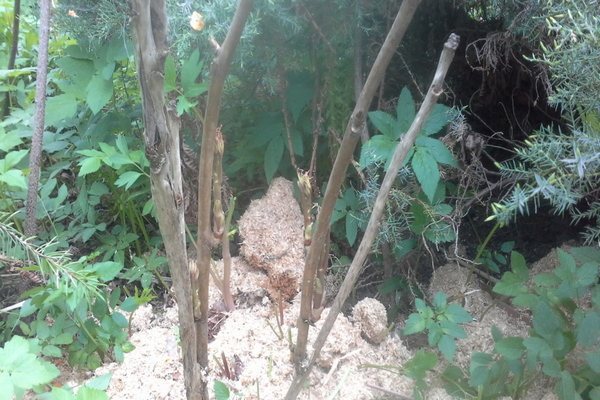

What fertilizers can be used to feed peonies in summer
From June to August, plants need potassium, phosphorus and trace elements (a complex in the form of tablets with boron, manganese, magnesium, copper, iron and other substances). These fertilizers help to strengthen the root system, the establishment of viable flower buds. Correct, timely feeding increases immunity, flowers endure winter more easily and do not get sick.
Diseases and pests
Tree peonies in the Moscow region are susceptible to infection with fungal diseases. Subject to all the rules of agricultural technology, plant immunity is stable.
Powdery mildew spreads quickly. The fungus does not do much harm to the health of the bush, but spoils the appearance of the foliage. Large white spots appear on it. They use fungicides, soap or soda solutions to fight.
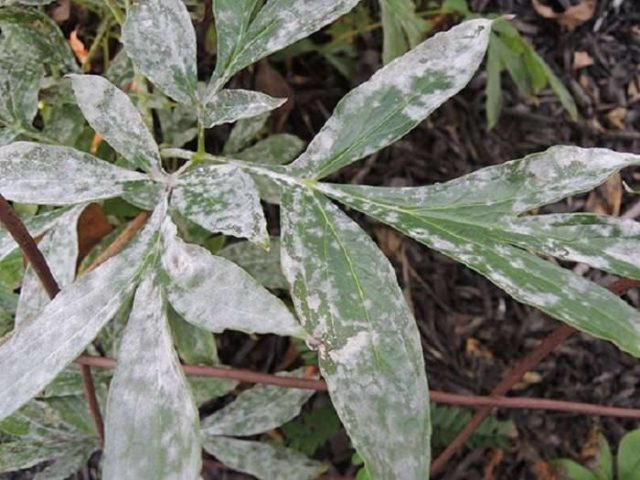

Powdery mildew spreads in 2-3 weeks on all leaves
Brown spot appears as dark spots spread over all leaves. At an advanced stage, the peony may die. To fight, remove all damaged shoots and burn them. The shrub is treated with Bordeaux mixture or fungicide.
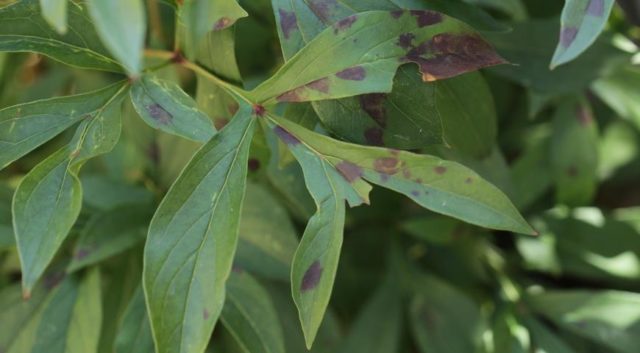

With brown spotting, spots cover the foliage, sunken cavities form in the center
Gray rot occurs due to overflow of the plant. Leaf disease begins, then it affects the buds. If you do not provide assistance in a timely manner, the fungus will spread to the roots, which will lead to complete death. For the fight use copper sulfate, potassium permanganate, fungicide.
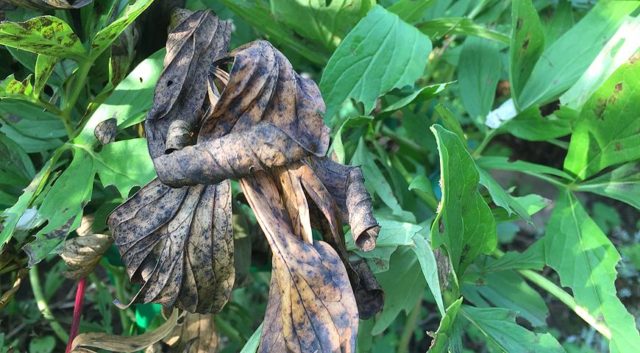

Gray rot is the worst disease of peonies
Ants were seen among pests on peonies. They make their way inside the buds and feed on the petals.
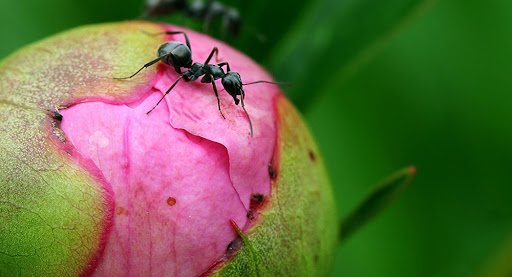

If ants eat a peony, then there is an anthill nearby.
Aphids penetrate into the dense crown of the bush and begin to actively reproduce there. Insects eat the leaves of peonies, leaving holes on the shoots. In an advanced stage, the flower dies due to a lack of nutrients. An insecticide will help in the fight.
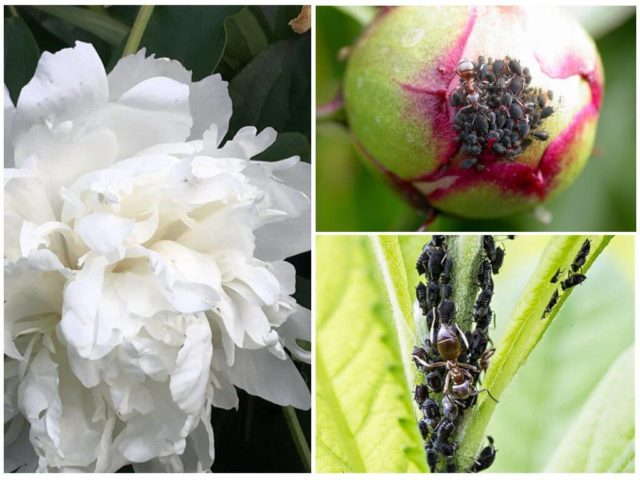

Aphids multiply quickly and can kill the bush in a couple of weeks.
Nematodes are parasites that attack the root system. It is difficult to cure the plant, so the peony is transplanted. The life cycle of the parasite is 10 years.
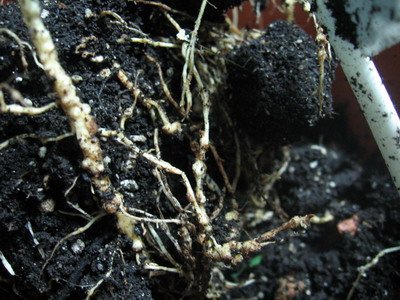

In winter, nematodes live in the soil in the form of capsules, and in the spring they come out of them and begin to infect the root system.
Array
Condition 2. Carry out autumn feeding
Before winter, peonies need to be given the opportunity to gain strength. Therefore, as an experienced gardener, I pay special attention to caring for peonies in the fall. Autumn feeding with fertilizers with a minimum nitrogen content is very important, since this element is more relevant for plants in spring.
In autumn, peonies need more phosphorus and potassium. I fertilize peonies with dry or liquid dressings from mid-September to early October.
Here are some options for how to saturate peonies with useful substances:
| Method 1. Bird droppings It can be used as an alternative to mullein. Cooking method:
Application:
|
| Method 2. Kemira-Kombi Complex mineral fertilizer with a balanced amount of nutrients. Release form: in granules and in the form of a solution. Structure: phosphorus, potassium, magnesium, zinc and other trace elements. Dosage and Application: a handful of dry matter in the form of granules, distribute around the peony bush |
| Method 3. Baikal EM-1 Fertilizer to improve soil quality. Release form: aqueous (up to 1 liter) or concentrated (40 ml) solution. Structure: contains live microorganisms. Dosage: according to the instructions and depending on the form of release. Application:
|
| Method 4. Superphosphate A popular effective preparation for feeding fruit and vegetable and flower crops, stimulating their growth. Used for neutral and alkaline soils. Release form: granules in bags of different packaging. Structure: the basis of fertilizer is phosphorus compounds, minerals, for example, sulfur, magnesium, calcium, potassium, nitrogen. Dosage: 50 g per 1 m². Application: add to the soil when digging it in the fall | |
| Method 5. Autumn A novelty in the potash-phosphorus fertilizers market. Unlike analogues, the same superphosphate does not contain nitrogen. Release form: bags with granules of different packing. Structure: potassium and phosphorus compounds. Dosage: 50 g per 1 m². Application: bring in when digging up the soil. |
Shelter peonies for the winter
The shelter of peonies is necessary, since the growth buds are located close to the soil surface, at a depth of only 3-7 cm and they must be protected from frost.
Depending on the climatic conditions, the shelter of peonies for the winter is slightly different. But where it is necessary to protect bushes, the general principles are as follows:
- After pruning the bushes in the fall, they need to be spud.
- On top, lay a layer of mulch with a thickness of at least 15-18 cm.
- In tree peonies, the root system is covered with a layer of peat 20-25 cm, and the stems are covered with lutrasil.
- As a covering material, sawdust, spruce branches, high peat, dry foliage, humus or compost are used.
- You can not use the cut foliage of the peonies themselves, straw, so as not to infect.
- In winter, additionally cover the peonies with a layer of snow to protect them from extreme cold.
- When removing the material in the spring, you can leave it partially left as mulch.
Fertilizers for peonies in autumn
Autumn feeding of peonies for the winter involves the use of organic or mineral fertilizers. For good nutrition, it is better to use them together:
- At the beginning of autumn, before pruning, the culture must be fed with minerals.
- After pruning - animal and plant organic matter.
Many people use folk remedies after flowering for plant nutrition, the effectiveness of which has long been proven in practice.
If you add nitrogenous fertilizers to the soil in the fall, provoking the development of green mass, then the flower, instead of preparing for winter, will spend energy on growth, weaken and even die.
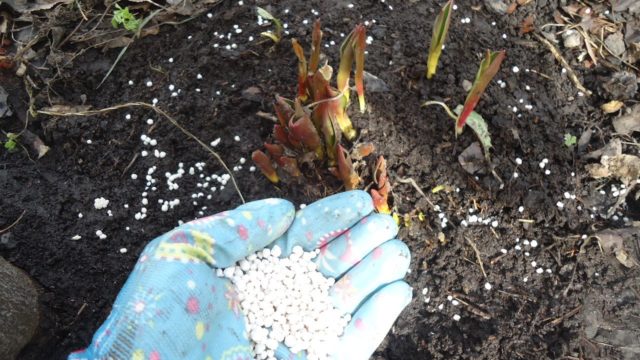

Fertilizers should not fall into the middle of the rhizome


